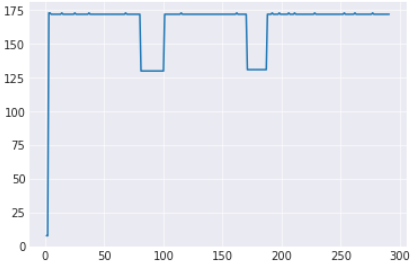时间序列 - 识别方波型信号的方法
我正在尝试寻找一种方法来过滤掉具有如下所示模式的信号。
该模式可以描述为具有方波,通常在多个时间段内具有恒定的波动值+-1、+-2 或+-0。信号通常会瞬间下降到 5-100 标准差,然后在很短的时间内保持恒定速率,然后再次回升。这些类型的信号可以具有单个或多个不同长度的方波,但信号中始终呈现方波。

我需要找到一种方法,可以帮助我从大约 3000 个信号中聚类出或过滤掉这些信号。我尝试了以下方法并得到了非常复杂的结果:
使用 TSLearn 和 DTW python 包对数字方差相关特征进行单变量时间序列聚类(混合结果)
使用 K-Means、KNN 等进行多元聚类(通常可以为单个信号分配多个聚类。规则是一个信号对应一个桶,而不是多个桶)
在数组中查找子序列的条件逻辑,希望找到方波(我对此无能为力,因为良好信号的一半长度可以等于信号重要部分的长度的一半;方波)
核分布估计(我有其他信号与该信号具有相同的分布,因此我无法根据系数的排名/聚类过滤掉这些信号)
您能否推荐其他方法来帮助我从一组其他信号中识别此类信号?如果您的方法是傅里叶变换,您能否提供一个示例,说明我如何使用它从一组其他信号中过滤掉该信号?
 蛊毒传说
蛊毒传说浏览 354回答 1
1回答
-

ITMISS
这将做到这一点:def first_der(df): y = df.NREVS.values x = df.cum_int.values dy=np.diff(y,1) dx=np.diff(x,1) yfirst=dy/dx return yfirstdef zero_runs(yfirst): # Create an array that is 1 where a is 0, and pad each end with an extra 0. iszero = np.concatenate(([0], np.equal(a, 0).view(np.int8), [0])) absdiff = np.abs(np.diff(iszero)) # Runs start and end where absdiff is 1. ranges = np.where(absdiff == 1)[0].reshape(-1,2) return yind def square_finder(yfirst, yind, df): xmax = yind.shape[0] #max value in first position where y_first can be indexed ymax = yind.shape[1] #max value in second position thresh = 4 for i in range(0,xmax): if yind[i][1] < len(yfirst): if ((yfirst[yind[i][1]] > 5) | (yfirst[yind[i][1]] < -5)): #if ((yfirst[yind[i-1][1]+1] > 3) | (yfirst[yind[i-1][1]+1] < -3)): zeros = yind[i][1] - yind[i-1][1] - 2 if zeros >= thresh: df['category'] = 'square' else: pass else: pass else: pass return df
 随时随地看视频慕课网APP
随时随地看视频慕课网APP
相关分类

 Python
Python